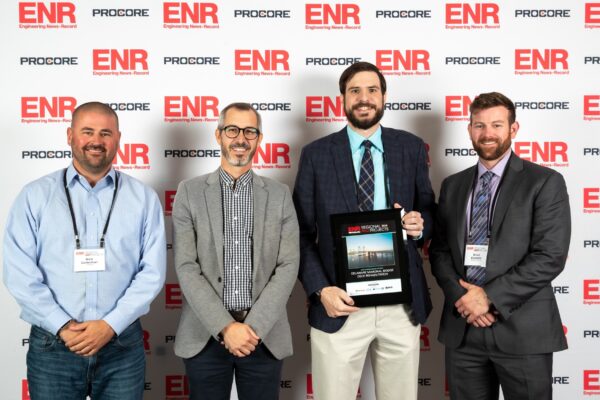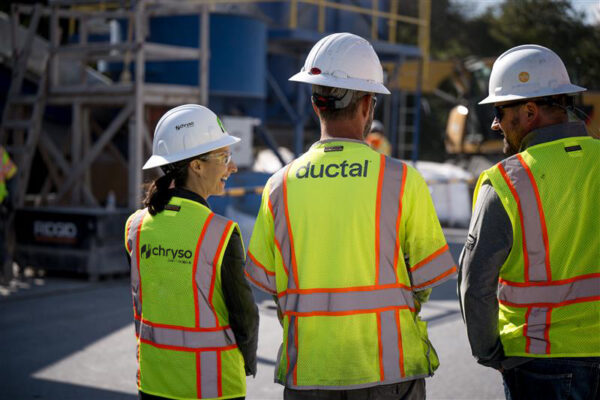Recommended Placing, Finishing and Curing Procedures for FORCE 10,000D® Concrete Flatwork – TB-0701

When FORCE 10,000D® concrete mixes are used in flatwork such as parking garage floors, bridge decks, etc., it is critical that appropriate placing, finishing and curing procedures are established prior to job start-up and enforced while the job is underway. With silica fume concrete placing, finishing and curing operations require attention to detail, and should be performed in a continuous operation. This bulletin highlights the
concreting procedures that have proven effective with FORCE 10,000D® flatwork placements. These recommendations amplify the accepted concreting practices set down by ACI. Particular attention should be paid to the following ACI Concrete Practices standards:
- ACI 211, “Standard Practice for Proportioning Concrete”
- ACI 234, “Guide for the Use of Silica Fume in Concrete”
- ACI 302, “Guide for Concrete Floor and Slab Construction”
- ACI 304, “Guide for Measuring, Mixing, Transporting and Placing Concrete”
- ACI 305, “Hot Weather Concreting”
- ACI 306, “Cold Weather Concreting”
- ACI 308, “Standard Practice for Curing Concrete”
- ACI 309, “Standard Practice for Consolidating Concrete”
The following information is intended as a guide to help insure that FORCE 10,000D® concrete is placed, finished and cured in a manner that will produce optimum performance results.
Surface Protection is Critically Important
Concrete containing FORCE 10,000D® is typically a low water/cementitious ratio mix. This type of concrete has less bleed water at the concrete surface making the surface extremely susceptible to rapid surface drying and plastic drying shrinkage if it is not protected.
- Rapid Surface Drying—The surface concrete dries out and hardens faster than the underlying concrete. This differential setting impairs finishing operations. To prevent rapid surface drying and plastic-shrinkage cracking, surface protection techniques described in ACI 234, ACI 302, ACI 305 and ACI 306 must be reviewed.
- Plastic-Shrinkage Cracking—Water evaporates from the surface after the concrete is placed. Tensile forces develop within the paste as a result of the volume reduction. Eventually the tensile forces exceed the tensile strength of the paste and surface cracks develop.
The following ACI recommend procedures are particularly helpful during finishing operations:
- Fog/Mist—Due to the low amount of bleed water in FORCE 10,000D® concrete, fog misting after placement but before other curing methods are used is strongly encouraged to reduce plastic-shrinkage cracks. A properly used fog or misting spray maintains the air above the slab at 100% relative humidity and provides the most effective surface protection available. Misting should continue throughout the finishing operations, but avoid over-wetting the concrete surface, which may impair the quality of the surface.
- Evaporative Surface Retardant—The application of a fog or mist spray may be supplemented and, in some circumstances, replaced with an evaporative surface retardant. These are designed to provide sacrificial evaporation so that surface moisture does not dissipate. They are not intended to be used as an alternative to sprinkling water on the surface as a finishing aid. Ensure that manufacturer’s recommendations are closely followed.
- Windbreaks—Windy conditions during placement and finishing increase the evaporation of surface moisture from the concrete. An increase in wind speed from 0 to 16 km/hr (0 to 10 mph) will quadruple the rate of evaporation. A windbreak will always be helpful when placing silica fume concrete, and on some days be absolutely necessary.
Placement
- Placement Devices—Placement devices that work for conventional concrete are also suitable for FORCE 10,000D® concrete. FORCE 10,000D® concrete mixes can be pumped, bucketed, tremied, etc.
- Slump Adjustment—FORCE 10,000D® concrete is more cohesive than conventional concrete, therefore, it is typically placed at a slump 25 mm to 50 mm (1 in. to 2 in.) higher than the slump of a conventional mix used in a similar placement. Use a superplasticizer such as ADVA® to make slump adjustments. Re-dosing at the job site with a superplasticizer is acceptable.
- Consolidation—FORCE 10,000D® concrete likes vibration. Proper consolidation through vibration is required even though the concrete is usually placed at a slump of 150 mm (6 in.) or greater. While ACI 302 recommends against using a vibratory screed on concrete with a slump greater than 75 mm (3 in.), field experience has shown that for silica fume placements of 85 mm (3.5 in.) in depth or less, a vibratory screed provides sufficient consolidation without impairing the surface quality. For placements of increased depth, internal vibration is required to ensure proper consolidation, particularly if rebar is present.
Finishing
A general approach to finishing FORCE 10,000D® concrete is to under finish the surface.
- Vibratory Screed—This is the best and easiest way to finish FORCE 10,000D® concrete. When using a vibratory screed, any bull-floating of the concrete should take place immediately behind the screed. Maintain surface humidity by frequent fogging or misting. An evaporative surface retardant may also be used if atmospheric conditions allow. See precautions above.
- Hand Screed—Hand screeding should be done with a sawing motion rather than a pulling motion in order to close the surface. Bull-floating should take place immediately following screeding.
- Brooming—If a broom finish is specified, the concrete should be broomed as soon as the surface can withstand the weight of the broom and provide a finish that is satisfactory to the owner. Often, this operation occurs soon after bull-floating.
- Power Finishing—The surface of silica fume concrete is prone to excessive drying during the delay that is required for the concrete to support the power equipment. This delay may be considerable due to the setting characteristics of the particular mix and the ambient temperature conditions. Be prepared for this. During this critical period, the protection techniques mentioned earlier are vital. Failure to prevent surface drying will encourage plastic-shrinkage cracking and increase the likelihood of premature surface hardening. Attempts to power finish when the surface is prematurely set and the interior of the concrete is still soft may result in an unacceptable finish. Delay power finishing until the interior concrete has reached the required set. Again, this scenario is avoided by maintaining adequate surface protection throughout the entire placement and finishing operation.
Curing
All concrete requires curing, however FORCE 10,000D® concrete requires additional attention as compared to ordinary concrete. Follow the recommendations provided in ACI 308.
- Wet Curing—Curing with wet burlap for 7 days is the best possible method. In some instances, where chemical resistance is needed, 28 days moist curing is required. ACI 234 recommends a minimum of 3 days moist curing may be used but preferably 5–7 days, followed by an application of a curing compound if only 3 day wet curing is used. The burlap should be placed as soon as the concrete can withstand the weight of the burlap without damaging the surface. It should be pre-wetted and maintained wet as long as specified.
- Thermal Protection—The subjection of newly-hardened concrete to rapid changes in temperature may result in thermal cracking. The possibility of thermal cracking of slabs, columns, beams and walls should be prepared for, and the recommendations offered by ACI 305, “Hot Weather Concreting” and ACI 306, “Cold Weather Concreting” should be reviewed prior to job start-up.





